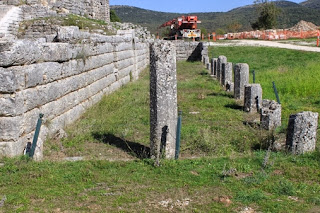I will have two major things in my life for the spring and summer ahead of me. Firstly, I have to proceed with the essential publications I need to get out. Secondly, I have to fit in my summer holiday allowance, i.e., about four weeks over summer. Wait a minute! I have actually more things, since I also have to work around the Volterra field school, the remaining teaching related to it during the summer term and then – the dreaded bit – try to have some work lined up for the next winter. Is that five things? And I could actually add some more, even if the dealing with the family responsibilities goes with the summer holiday allowance...
The last matter – trying to come up with work/money/position for the next winter has taken a disproportionate share of my time recently. This is partly because the high season for hiring is early in the year for the next autumn and partly because that is the application season in Sweden. Talking about the academic landscapes. The wry highlight of the last two weeks is dealing with a major application from start to finish in basically 24 hours. I started around late morning on a Thursday and finished the following morning after proofreading my own text. This included editing my CV and publication list to the format and length required and calculating a budget. I did have to wait until late afternoon for the head of the department’s signature, but that was out of my control. Meeting schedules, you see.
The major project has been the second round of an application process at Oslo. I must admit that even if I did know from my earlier Finnish experience that one should have work certificates – automatically provided by the Universities and available easily after finishing even a short contract in the Nordic countries – I had wilfully ignored the whole matter, since there is no tradition for them in England. The reference tradition means that you ask a couple of people who have followed your career for certain stretches to guarantee that you are not making things up in your CV – even if choosing and showing off in a positive light is allowed. Now it was retribution time...
In principle, I had less than a month – or actually in two and half weeks – to create a portfolio that gives evidence of all I had done to that point. This resulted with fervent e-mailing exercise to those parties I had taught for and worked for. I was tracking down people to Brasil and other places in order to have a scanned file of a few months exercises. I managed to do it, although it turned out that any evidence for those computer courses at Cambridge are in my old handouts gathering dust in Leicester. With the change of management system, all earlier computer records at Cambridge had vanished seven years ago. Ironically, this job is in Digital Documentation, so I got more experience than I could have hoped for!

